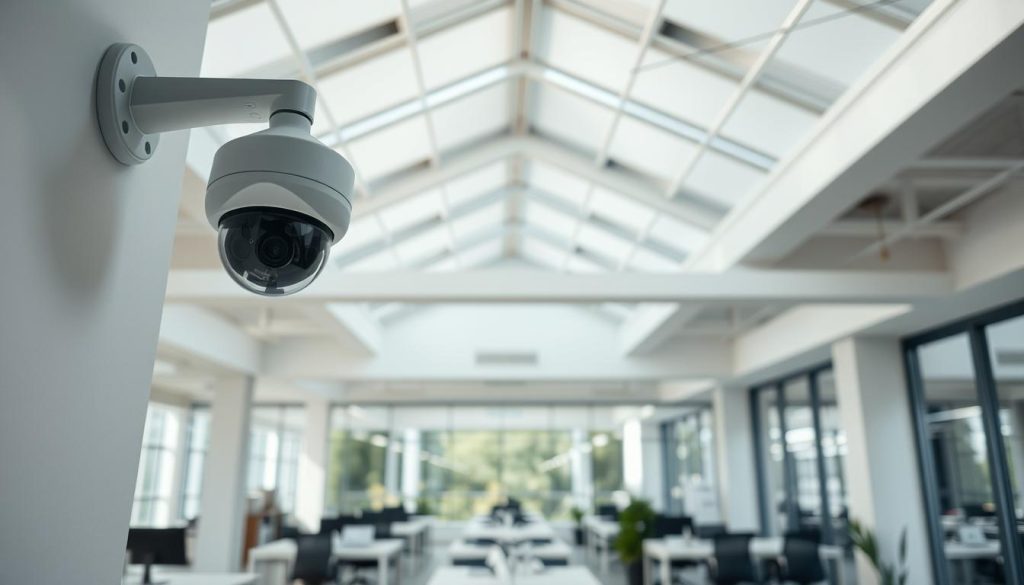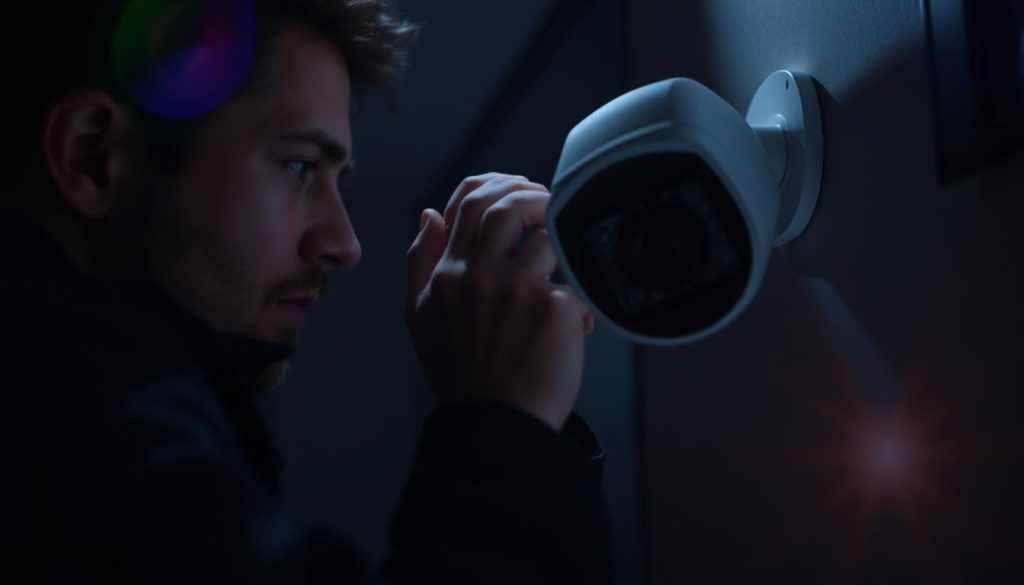A security camera with poor image quality can compromise safety. Whether it’s due to environmental factors or technical issues, unclear footage reduces effectiveness. In Singapore’s humid climate, condensation and lens fogging often worsen the problem.
Common issues include low-light performance, misaligned focus, or dirty lenses. Simple adjustments like cleaning the lens or adjusting settings can restore clarity. For persistent problems, professional solutions may be needed.
This guide covers practical steps to enhance security without costly upgrades. From hardware checks to environmental fixes, we’ll help you troubleshoot efficiently.
Key Takeaways
- Clear footage is vital for effective surveillance.
- Humidity in Singapore can affect camera performance.
- Basic maintenance often resolves blurry images.
- Adjusting settings improves low-light visibility.
- Professional help is optional for severe cases.
How Do You Fix a Blurry CCTV Camera? Start With These Checks
Blurry footage from surveillance systems often stems from simple, overlooked issues. Before considering replacements, perform these basic diagnostics to restore clarity. Many problems—like dust buildup or unstable power—are quick to resolve.
Identifying Common Causes of Blurry Security Footage
Nearly 40% of blurry camera image cases result from dirty lenses. Spiderwebs, dust, or condensation obstruct the view. Outdoor security cameras in Singapore’s humidity are especially prone to fogging.
Electrical issues like voltage drops or mismatched power (12V vs. 24V) also degrade quality. Always check power supply connections with a multimeter. Cables longer than 300ft or damaged by rodents can disrupt signals.
Quick Diagnostic Steps for Immediate Improvement
Follow this systematic approach:
- Clean the lens: Use a microfiber cloth to remove debris gently.
- Test power: Verify voltage matches specifications and connections are secure.
- Inspect cables: Look for frayed wires or weather damage in outdoor setups.
- Swap ports: Connect the camera to another DVR/NVR port to isolate faults.
For persistent problems, reboot the system and check infrared functionality. These steps often resolve minor issues without professional help.
Cleaning Your CCTV Camera for Optimal Clarity
Dust and humidity often degrade security footage quality over time. Regular maintenance ensures your camera lens captures sharp images, especially in Singapore’s humid climate. Follow these steps to restore and preserve clarity.
Proper Lens Cleaning Techniques
Begin by powering off the device to avoid electrical damage. Use a microfiber cloth lightly dampened with isopropyl alcohol. Gently wipe the camera lens in circular motions to remove dust or fingerprints.
Avoid paper towels or harsh chemicals—they scratch coatings. For stubborn grime, apply alcohol sparingly and wipe again with a dry cloth.
Removing Condensation from Housings
Outdoor units frequently suffer from foggy lenses due to temperature shifts. Place silica gel packets inside the housing to absorb moisture. For immediate fixes, use a hairdryer on low heat 12 inches from the camera lens.
Prevent future fogging by applying anti-fog spray monthly. Check weatherproofing seals and reapply silicone grease if cracked.
- Monthly maintenance: Inspect lenses and housings in high-humidity areas.
- DIY hack: Store cameras with silica gel packs during monsoon seasons.
- Warning: Never spray liquids directly onto the lens.
Adjusting Camera Focus and Zoom Settings
Varifocal lenses offer flexibility but require precise calibration for sharp results. Misaligned settings often cause distorted or pixelated footage. Simple tweaks can significantly enhance image quality, especially in Singapore’s unique urban layouts.
Manual Focus Correction for Varifocal Cameras
Use live monitoring to adjust focus while displaying a test pattern. Rotate the lens ring until edges appear crisp. For HDB corridors, prioritize mid-range focus to cover narrow angles effectively.
Smartphone apps like iCamMonitor assist DIY installations. Align crosshairs on-screen to fine-tune without professional tools. “Live adjustments prevent guesswork,” notes a Singaporean security technician.
Optimal Zoom Settings for Surveillance Areas
Balance zoom and focus for specific needs:
- License plates: Higher zoom (≥5x) with tight focus on entry/exit points.
- Facial recognition: Wider angles (2.8mm) in retail spaces to capture full-body profiles.
- HDB corridors: 3.6mm lenses reduce distortion in confined spaces.
Preset configurations save time. Retail stores benefit from auto-zoom on cashier areas, while residential setups prioritize wide coverage. Regularly test resolution under different lighting to maintain clarity.
Improving Night Vision Performance
Clear nighttime footage requires precise adjustments to infrared settings. In Singapore’s urban areas, ambient light and weather factors can distort images. Proper calibration ensures your system delivers sharp results after dark.
Optimizing IR Settings for Clear Nighttime Footage
Adjust IR intensity based on surveillance range. For 5-meter corridors, lower settings reduce glare. Wider areas like car parks need 30-meter coverage with higher intensity.
Modern cameras like the Reolink Argus 3 Pro offer dual-light systems. These combine infrared and white light for detailed color images at night. Bracket shields prevent adjacent light interference.
Solving Infrared Reflection Problems
Glass surfaces or polished walls often cause IR glare. Reposition cameras at a 15-degree angle to avoid reflections. Anti-fog housings combat Singapore’s humidity, maintaining performance.
- Upgrade tip: Choose models with color night vision for车牌 recognition.
- Installation hack: Test IR settings during dusk to balance visibility.
Addressing Power Supply and Cable Issues
Electrical inconsistencies often cause unexpected blurriness in surveillance footage. A stable power supply ensures consistent performance, especially for 4K systems common in Singaporean commercial installations. Voltage drops beyond 5% can distort images without triggering obvious error alerts.
Diagnosing Voltage Fluctuations
Use a multimeter to test input voltage at both the camera and recorder ends. For runs exceeding 100ft, calculate expected drops using this formula:
- Voltage drop = (Current × Length × Resistance) ÷ Cable gauge factor
- PoE systems require 48V at source for stable 4K connection
- IMDA-compliant installations mandate pure copper conductors (≥99.9%)
Cable Selection for Tropical Climates
Singapore’s humidity demands weather-resistant cables with UV-stabilized jackets. Key specifications:
- Cat6 shielded twisted pair for ≤300ft runs
- Waterproof gel-filled conduits for underground routing
- Corrosion-resistant RJ45 connectors for coastal areas
Professional installers recommend testing tech setups during afternoon thunderstorms when voltage fluctuations peak. This identifies weak points before permanent damage occurs.
Optimizing Camera Placement for Clearer Images
Singapore’s architectural diversity demands customized camera placement strategies. High-rise HDB blocks, glass-fronted malls, and narrow shop houses each require unique positioning approaches. Proper installation height and angle prevent common issues like distorted perspectives and glare.
Height Guidelines for Urban Surveillance
Mounting between 8-10 feet achieves optimal coverage while deterring tampering. This elevation captures facial details without extreme upward angles that distort proportions. For HDB void decks, position units beneath overhead lights to enhance nighttime visibility.

Ground-level installations need anti-vandal housings angled downward at 15°. Commercial spaces benefit from ceiling mounts with 360° rotation for retail surveillance. Always consider human traffic flow when finalizing heights.
Combatting Reflection Challenges
Glass facades in Singapore’s business districts create problematic reflections. Position cameras perpendicular to windows or use polarized filters. For unavoidable glare, 3D simulation tools like iSpy preview blind spots before installation.
Key positioning solutions include:
- Angled brackets to avoid direct light sources
- Seasonal sun path analysis for outdoor units
- Testing different times of day for glare patterns
Modern systems with wide dynamic range compensate for challenging lighting. However, proper placement remains the most cost-effective clarity improvement for existing cameras.
Adjusting Camera Resolution and Video Settings
Modern security systems demand careful calibration of digital settings for sharp footage. The right combination of resolution and video parameters ensures your surveillance captures actionable details. Singaporean installations often require custom configurations for high-rise buildings and crowded public spaces.
Setting the Right Resolution for Surveillance Needs
4MP (1440p) strikes the ideal balance between image quality and storage efficiency for most applications. Shopping malls benefit from higher resolutions for facial recognition, while HDB corridors may prioritize wider coverage over pixel density.
- Storage limitations: 4K systems require 3x more space than 1080p
- H.265+ encoding reduces file sizes by 50% without quality loss
- Monitor compatibility: Older displays may not support ultra-HD streams
Balancing Brightness and Contrast for Clear Images
Singapore’s mixed lighting conditions challenge image quality. Wide Dynamic Range (WDR) settings compensate for shadows and bright spots in shophouse alleys. Set contrast ratios between 60-70% for optimal detail retention.
Mobile apps like Hik-Connect simplify adjustments:
- Create lighting profiles for dawn/dusk transitions
- Enable smart IR for consistent night footage
- Adjust gamma curves to reduce monsoon season haze
For Orchard Road storefronts, test video configurations during peak sunlight hours. Temporary overexposure helps identify needed adjustments before critical events occur.
Environmental Factors Affecting CCTV Clarity
Singapore’s tropical environment presents unique challenges for surveillance systems. High humidity, frequent rain, and salty coastal air create multiple factors that degrade image quality over time. Proper protection extends equipment lifespan while maintaining clear footage.
Protecting Devices From Humidity Damage
Relative humidity averaging 84% accelerates lens fogging and circuit corrosion. Use silica gel packets inside housings to absorb moisture—replace them monthly during monsoon seasons. Anti-fungal treatments prevent rubber gasket deterioration in constantly damp conditions.
For coastal installations, choose marine-grade stainless steel brackets. They resist salt spray corrosion better than standard aluminum. Problems with condensation often disappear after applying weatherproof silicone to housing seams.
Combatting Weather-Related Distortion
Heavy rain creates visibility issues even with waterproof ratings. Install angled shields above outdoor units to deflect precipitation. Position cameras under eaves when possible, maintaining a 30° downward tilt for optimal coverage.
- Heat management: White housings reflect sunlight better than dark colors in direct sun exposure areas
- Monsoon prep: Check NEA forecasts to schedule maintenance before peak rainfall months
- Coastal solutions: Use dielectric grease on all electrical connections near shorelines
For persistent weather interference, consider upgrading to professional-grade housings with active temperature control. These maintain optimal operating conditions despite Singapore’s challenging climate.
When to Consider Professional Help or Camera Upgrades
Singapore’s evolving security standards require periodic tech evaluations. When basic troubleshooting fails, certified installers can assess whether repairs or upgrades offer better value. The Productivity Solutions Grant (PSG) now covers modern surveillance solutions for SMEs.
Newer cameras often need compatible NVR systems. Enterprise-grade models outperform consumer versions in high-traffic areas. SGSecure-certified providers ensure proper installation for optimal performance.
Consider professional help when facing recurrent focus issues or outdated infrared tech. Many Singaporean suppliers offer free assessments to determine cost-effective solutions for your specific needs.

